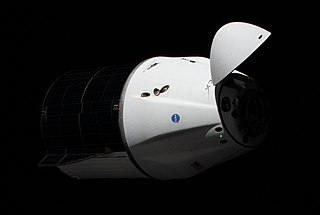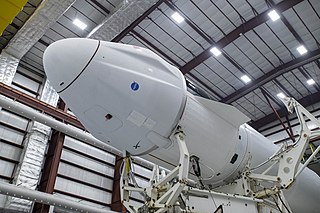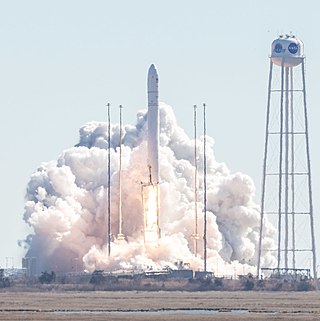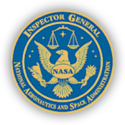
The Space Shuttle program was the fourth human spaceflight program carried out by the U.S. National Aeronautics and Space Administration (NASA), which accomplished routine transportation for Earth-to-orbit crew and cargo from 1981 to 2011. Its official name, Space Transportation System (STS), was taken from a 1969 plan for a system of reusable spacecraft of which it was the only item funded for development. It flew 135 missions and carried 355 astronauts from 16 countries, many on multiple trips.

Dream Chaser is an American reusable lifting-body spaceplane being developed by Sierra Space. Originally intended as a crewed vehicle, the Dream Chaser Space System is set to be produced after the Dream Chaser Cargo System cargo variant is operational. The crewed variant is planned to carry up to seven people and cargo to and from low Earth orbit.

The Michoud Assembly Facility (MAF) is an 832-acre manufacturing complex owned by NASA in New Orleans East, a section of New Orleans, Louisiana, in the United States. Organizationally it is part of NASA's Marshall Space Flight Center, and is currently a multi-tenant complex to allow commercial and government contractors, as well as government agencies, to use the site.

The Crew Return Vehicle (CRV), sometimes referred to as the Assured Crew Return Vehicle (ACRV), was a proposed dedicated lifeboat or escape module for the International Space Station (ISS). A number of different vehicles and designs were considered over two decades – with several flying as developmental test prototypes – but none became operational. Since the arrival of the first permanent crew to the ISS in 2000, the emergency return capability has been fulfilled by Soyuz spacecraft and, more recently, SpaceX's Crew Dragon – each rotated every 6 months.

Commercial Resupply Services (CRS) are a series of flights awarded by NASA for the delivery of cargo and supplies to the International Space Station (ISS) on commercially operated spacecraft. The first CRS contracts were signed in 2008 and awarded $1.6 billion to SpaceX for twelve cargo Dragon and $1.9 billion to Orbital Sciences for eight Cygnus flights, covering deliveries to 2016. The Falcon 9 and Antares rockets were also developed under the CRS program to deliver cargo spacecraft to the ISS.

The Boeing Starliner is a class of two partially reusable spacecraft designed to transport crew to the International Space Station (ISS) and other low-Earth-orbit destinations. It is manufactured by Boeing, with the Commercial Crew Program (CCP) of NASA as the anchor customer. The spacecraft consists of a reusable crew capsule and an expendable service module.

Development of the Commercial Crew Program began in the second round of the Commercial Crew Development (CCDev) program, which was rescoped from a technology development program for human spaceflight to a competitive development program that would produce the spacecraft to be used in the Commercial Crew Program to provide crew transportation services to and from the International Space Station (ISS). To implement the program NASA awarded a series of competitive fixed-price contracts to private vendors starting in 2011. Operational contracts to fly astronauts were awarded in September 2014 to SpaceX and Boeing, and NASA expected each company to complete development and achieve crew rating in 2017. Each company performed an uncrewed orbital test flight in 2019. SpaceX operational flights started in November 2020.

The retirement of NASA's Space Shuttle fleet took place from March to July 2011. Discovery was the first of the three active Space Shuttles to be retired, completing its final mission on March 9, 2011; Endeavour did so on June 1. The final shuttle mission was completed with the landing of Atlantis on July 21, 2011, closing the 30-year Space Shuttle program.

The Space Launch System (SLS) is an American super heavy-lift expendable launch vehicle used by NASA. As the primary launch vehicle of the Artemis Moon landing program, SLS is designed to launch the crewed Orion spacecraft on a trans-lunar trajectory. The first SLS launch was the uncrewed Artemis 1, which took place on 16 November 2022.

OA-5, previously known as Orbital-5, was the seventh planned flight of the Orbital Sciences' uncrewed resupply spacecraft Cygnus and its sixth flight to the International Space Station under the Commercial Resupply Services contract with NASA. The mission launched on 17 October 2016 at 23:45:36 UTC. Orbital Sciences and NASA jointly developed a new space transportation system to provide commercial cargo resupply services to the International Space Station (ISS). Under the Commercial Orbital Transportation System (COTS) program, Orbital designed and built Antares, a medium-class launch vehicle; Cygnus, an advanced maneuvering spacecraft; and a Pressurized Cargo Module which is provided by Orbital's industrial partner Thales Alenia Space.

The Exploration Upper Stage (EUS) is a rocket stage under development that will be used for future flights of NASA's Space Launch System (SLS). Used on SLS Block 1B and Block 2, it will replace the SLS Block 1's Interim Cryogenic Propulsion Stage. The stage will be powered by four RL10C-3 engines burning liquid oxygen and liquid hydrogen to produce a total thrust of 433.1 kN (97,360 lbf). The EUS is expected to first fly on Artemis 4 in 2028.

OA-6, previously known as Orbital-6, is the sixth flight of the Orbital ATK uncrewed resupply spacecraft Cygnus and its fifth flight to the International Space Station under the Commercial Resupply Services (CRS) contract with NASA. The mission launched on 23 March 2016 at 03:05:52 UTC.

OA-9E was the tenth flight of the Orbital ATK uncrewed resupply spacecraft Cygnus and its ninth flight to the International Space Station (ISS) under the Commercial Resupply Services with NASA. The mission launched on 21 May 2018 at 08:44:06 UTC. Orbital ATK and NASA jointly developed a new space transportation system to provide commercial cargo resupply services to the International Space Station. Under the Commercial Orbital Transportation Services (COTS) program, then Orbital Sciences designed and built Antares, a medium-class launch vehicle; Cygnus, an advanced maneuvering spacecraft, and a Pressurized Cargo Module which is provided by Orbital's industrial partner Thales Alenia Space.

SpaceX CRS-21, also known as SpX-21, was a Commercial Resupply Service mission to the International Space Station which launched on 6 December 2020. The mission was contracted by NASA and was flown by SpaceX using a Cargo Dragon 2. This was the first flight for SpaceX under NASA's CRS Phase 2 contract awarded in January 2016. This was also the first Cargo Dragon of the new Dragon 2 variant, as well as the first Cargo Dragon flight that was docked at the same time as a Crew Dragon spacecraft. This mission used Booster B1058.4, becoming the first NASA mission to reuse a booster previously used on a non-NASA mission. This was also first time SpaceX launched a NASA payload on a booster with more than one previous flight.

SpaceX CRS-22, also known as SpX-22, was a Commercial Resupply Services (CRS) mission to the International Space Station (ISS) that launched at 17:29:15 UTC on 3 June 2021. The mission is contracted by NASA and is flown by SpaceX using a Cargo Dragon 2. This is the second flight for SpaceX under NASA's CRS Phase 2 contract awarded in January 2016.

The Commercial Crew Program (CCP) provides commercially operated crew transportation service to and from the International Space Station (ISS) under contract to NASA, conducting crew rotations between the expeditions of the International Space Station program. American space manufacturer SpaceX began providing service in 2020, using the Crew Dragon spacecraft, and NASA plans to add Boeing when its Boeing Starliner spacecraft becomes operational no earlier than 2025. NASA has contracted for six operational missions from Boeing and fourteen from SpaceX, ensuring sufficient support for ISS through 2030.

Dragon C208 is the first Cargo Dragon 2 spacecraft, and the first in a line of International Space Station resupply craft which replaced the Dragon capsule, manufactured by SpaceX. The mission is contracted by NASA under the Commercial Resupply Services (CRS) program. It flew for the first time on the CRS-21 mission on 6 December 2020. This was the first flight for SpaceX under NASA's CRS Phase 2 contract awarded in January 2016. This was also the first time a Cargo Dragon was docked at the same time as a Crew Dragon spacecraft. This mission used Booster B1058.4.

Cygnus NG-17, previously known as Cygnus OA-17, was the seventeenth flight of the Northrop Grumman robotic resupply spacecraft Cygnus and its sixteenth flight to the International Space Station (ISS) under the Commercial Resupply Services (CRS) contract with NASA. The mission launched on 19 February 2022 at 17:40:03 UTC. It was the sixth launch of Cygnus under the CRS-2 contract.

SpaceX CRS-26, also known as SpX-26, was a Commercial Resupply Service mission to the International Space Station (ISS) launched on 26 November 2022. The mission was contracted by NASA and flown by SpaceX using a Cargo Dragon. This was the sixth flight for SpaceX under NASA's CRS Phase 2 contract awarded in January 2016.



















